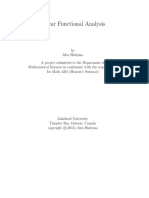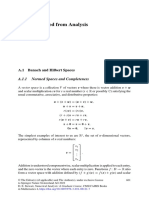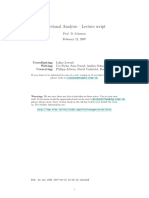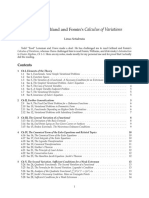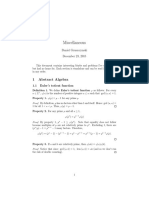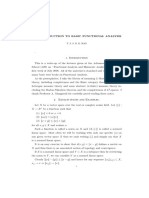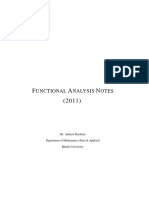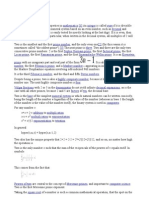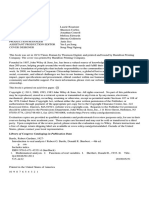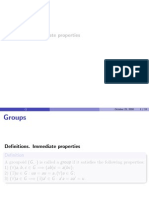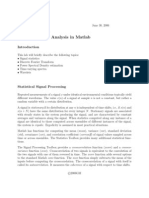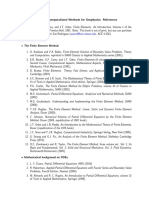Calculus of Variations
Claus Fhrer u Lund University claus@maths.lth.se Lund, Spring 2011
C. Fhrer (Lund University, Sweden): FMA200: Calculus of Variations u
�Unit 0: Preface
These notes serve as a skeleton for the course. They document together with the assignments the course outline and course content. All references in the notes refer to the textbook by Gelfand and Fomin if not otherwise stated. The notes are a guide to read the textbook. They are no textbook. Please report missprints or your comments to the teacher.
C. Fhrer (Lund University, Sweden): FMA200: Calculus of Variations u 1
�Unit 1: Elements of the Theory
Functionals Function spaces Variation of a functional Euler Equation
C. Fhrer (Lund University, Sweden): FMA200: Calculus of Variations u 2
�1.1 Functionals
Denition. Let V be a linear space of functions (e.g. L2) or an ane linear space. A map F :V R is called a functional on V
C. Fhrer (Lund University, Sweden): FMA200: Calculus of Variations u 3
�1.2 Functionals
Example. [Functional] Let V = {y C 1[a, b]|y(a) = A, y(b) = B} length of a curve J[y] =
b a
(Cont.)
1 + y (x)dx
velocity of a particle moving along a curve through xed points A, B denes a time the particle takes to move from A to B as a function of the curve. more general: J[y] =
b F (x, y(x), y a
(x)) dx for a given function F .
C. Fhrer (Lund University, Sweden): FMA200: Calculus of Variations u 4
�1.3 Variational Problems
Denition. The problem of nding a maximal or a minimal or a stationary value of a functional is called a variational problem. Example. [Variational Problem] nd the curves between A and B with shortest length nd the curve between A, B which is passed by a particle under gravity in shortest time. brachistochrone problem Let L be the set of closed curves with given length l. Find the one which encloses the largest area. isoperimetric problem
C. Fhrer (Lund University, Sweden): FMA200: Calculus of Variations u 5
�1.4 Localization Property
Denition. Functionals of the form J[y; a, b] = localization property, i.e.
n+1 b F (x, y, y a
)dx have the
J[y; a, b] =
i=1
J[y; xi1, xi] with a = x0 < . . . < xn+1 = b.
We only treat these kind of functionals here. Example. [nonlocal functional] Center of mass of a curve with homogeneous mass distribution J[y] =
b x a b a
1 + y 2dx 1+y
2 dx
b xds(x) a b ds(x) a
C. Fhrer (Lund University, Sweden): FMA200: Calculus of Variations u 6
�1.5 Finite Dimensional Problems
Let a = x0 < . . . xi < . . . < xn+1 = b and y V. We approximate y by the polygonal line p(y) passing through the points (xi, y(xi)) and J[y] by
n+1
J[y1, . . . , yn] =
i=1
F (xi, yi,
yi yi1 )(xi xi1) xi xi1
with yi = y(xi).
(Note, that y0 and yn+1 are xed by A and B .)
Finite dimensional Variational Problem min
(y1 ,...,yn )R
Innite dimensional tional Problem min J[y]
yV
Varia-
J[y1, . . . , yn] n
C. Fhrer (Lund University, Sweden): FMA200: Calculus of Variations u 7
�1.6 Linear Spaces
Denition. [Linear Space] A set V is called a linear space or a vector space over R if there are two operations + and with the following properties v1, v2 V v1 + v2 V v1 + v2 = v2 + v1 v1 + (v2 + v3) = (v1 + v2) + v3 There is an element 0V V with 0V + v = v + 0V = v There is an element v V with v + (v) = 0V
C. Fhrer (Lund University, Sweden): FMA200: Calculus of Variations u 8
�1.7: Linear Spaces (Cont.)
Rv V ( + ) v = v + v ( u) = () u (v1 + v2) = v1 + v2 1v =v One can then easily show 0 v = 0 and 1 v = v. The elements v of V are called vectors, the elements of R scalars.
C. Fhrer (Lund University, Sweden): FMA200: Calculus of Variations u 9
�1.8: Example of Linear Spaces
Rn, the nullspace and the column (range) space of a matrix space of all n m matrices space of all polynomials of (max-) degree n: P n space of all continuous functions C[a, b] space of all functions with a continuous rst derivative C 1[a, b] ....
Not a linear space: The set of all polynomials of degree n which have the property p(2) = 5. C. Fhrer (Lund University, Sweden): FMA200: Calculus of Variations u 10
�1.9: Normed Linear Spaces
We generalize the denition of the absolute value of a real number to norms of elements of a linear space: Denition. [norm] V a linear space , a function norm if for all u, v V and all R: v 0 and v = 0 v = 0 (Positivity) v = || v (Homogenity) u + v u + v (Triangle inequality) A linear space with a norm is called a normed linear space.
C. Fhrer (Lund University, Sweden): FMA200: Calculus of Variations u 11
: V R is called a
�1.10: Examples
Examples for norms: In Rn: 2-norm (Euclidean norm) v In C[a, b]: -norm f
2
n 2 1/2 vi i=1
= maxx[a,b] |f (x)|
In C 1[a, b]: C 1-norm f = maxx[a,b] |f (x)| + maxx[a,b] |f (x)| In L2[a, b]: L2-norm f
2
1/2 b f (x)2dx a
C. Fhrer (Lund University, Sweden): FMA200: Calculus of Variations u 12
�1.11: Completeness
Denition. [Cauchy sequence] Let V be a normed linear space, and let {vi} V be a sequence with the property i=0 > 0 N N m, n > N : vm vn < .
Such a sequence is called a Cauchy sequence.
Denition. [Complete Space] A linear space V is called complete if for any Cauchy sequence {vi} V there exists an element v V such that i=0 limi vi = v .
C. Fhrer (Lund University, Sweden): FMA200: Calculus of Variations u 13
�1.12: Continuous Functionals
With norms we can decide if two elements are close to each other and thus give a denition of continuity:
Denition. [Complete Space] It is continuous at y V if > 0 > 0 :
Let J be a functional on V.
y y < |J[y] J[]| < . y
(Note, the mixed use of norm and absolute value in this denition.) C. Fhrer (Lund University, Sweden): FMA200: Calculus of Variations u 14
�1.13: Ane Linear Spaces
To be able to describe boundary conditions correctly we later need the notion of an ane linear space:
Denition. [ane space] An ane linear space is a (point) set A together with a linear space V and a map + : AV A with (a, v) a+v such that For every a A is the map v a + v a bijection on A. For every w, v V and a A holds a + (w + v) + a = (a + w) + v.
C. Fhrer (Lund University, Sweden): FMA200: Calculus of Variations u 15
�1.14: Ane Linear Spaces
(Cont.)
Note, that the usual operations as + and product with a scalar are not dened in A. But we can dene b a = (a + w) (a + 0) =: w. (The dierence between two points is a vector.) Examples: A = {(, 2)| R} R2 The set of all polynomials of degree 2, which pass through the point (1, 1). The course book calls the elements of an ane linear function space admissible functions.
C. Fhrer (Lund University, Sweden): FMA200: Calculus of Variations u 16
�1.15: Ane Linear Spaces
(Cont.)
C. Fhrer (Lund University, Sweden): FMA200: Calculus of Variations u 17





